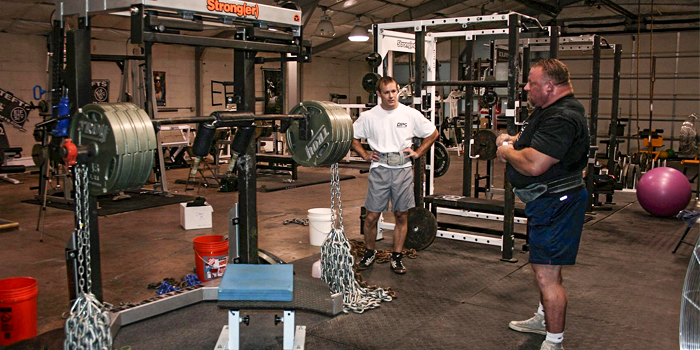
Rather than just writing one cycle, I’ve decided to make an easy-to-follow quasi-article containing all the different cycles for the squat I’ve used successfully. The first cycles will be for the Dynamic Effort squat without chains and bands. The second group will be with chains, and the last group will be with bands. Training with bands is still one of the most effective ways to train the squat. I’d recommend that everyone use bands all year round in some form or another.
A note about the percentages: These are taken off a contest squat with equipment. So if you’re lifting off a raw or no-equipment max, add 10% to all the percentages listed.
Squat Without Chains and Bands
Years ago, I’d have recommended a four-week squat wave, but after years of success in band training, I feel a three-week wave would be the most efficient. I also believe that there needs to be slightly different percentages based on the motor control of the athlete. This control is based on years of training, not the status of the athlete. For example, a beginner would have one to three years of training, the intermediate three to five years, and the advanced lifter over five years. The reason for this is quite simple: the more advanced athlete knows how to use his body more efficiently than the beginner and gets more out of a smaller percentage.
Beginner
- Week 1: 63% for 10 sets of 2 reps
- Week 2: 65% for 10 sets of 2 reps
- Week 3: 68% for 10 sets of 2 reps
The beginner has a couple more sets than the advanced and intermediate lifter. This is to improve the form of the lifter. The main goal of the beginner is to have perfect form, so in many cases, ten sets still won’t be enough and should be taken as high as twelve sets.
Intermediate
- Week 1: 60% for 8 sets of 2 reps
- Week 2: 63% for 8 sets of 2 reps
- Week 3: 65% for 8 sets of 2 reps
Advanced
- Week 1: 55% for 8 sets of 2 reps
- Week 2: 58% for 8 sets of 2 reps
- Week 3: 60% for 8 sets of 2 reps
Squatting with Chains
Beginner
- Week 1: 63% for 10 sets of 2 reps
- Week 2: 65% for 10 sets of 2 reps
- Week 3: 68% for 10 sets of 2 reps
Four to six reps over the three weeks must be above training percent. This is done in addition to the regular sets.
Intermediate
- Week 1: 60% for 8 sets of 2 reps
- Week 2: 63% for 8 sets of 2 reps
- Week 3: 65% for 8 sets of 2 reps
Four to six reps over the three weeks must be above training percent. This is done in addition to the regular sets.
Advanced
- Week 1: 55% for 8 sets of 2 reps
- Week 2: 58% for 8 sets of 2 reps
- Week 3: 60% for 8 sets of 2 reps
Four to six reps over the three weeks must be above training percent. This is done in addition to the regular sets.
Recommended Chains for Squatting
- Squat Max 200-400 Pounds = 60-pound chain
- Squat Max 400-500 Pounds = 80-pound chain
- Squat Max 500-600 Pounds = 100-pound chain
- Squat Max 700-800 Pounds = 120-pound chain
- Squat Max 800-900 Pounds = 160-pound chain
The chains are added to the weight of the barbell. Warm up with the chains on the bar first, then add the weights. When the barbell is in the rack, four to five links of chain should be resting on the floor. At no point should all of the chain be off the floor during the squat.
Squat Cycles with Bands
These cycles are only for intermediate and advanced lifters. The beginners would be better off sticking with straight weight or chains. If the beginner would like to use bands with his squat, then I’d suggest keeping the tension minimal and reducing the training loads by 10%.
Regular Training Phase (or Strength Speed)
- Week 1: 47% (RG Band) 8 sets of 2
- Week 2: 51% (RG Band) 8 sets of 2
- Week 3: 53% (RG band) 8 sets of 2
Four to six reps over the three weeks must be above training percent. This is done in addition to the regular sets.
This phase should be the core of your training and can be "waved" one after another. For better results, mixing in one of the Speed Strength phases after every couple of regular phases would be best.
Speed Strength Phase A
- Week 1: 15% (SS Band) 5 sets of 2
- Week 2: 20% (SS Band) 5 sets of 2
- Week 3: 25% (SS band) 5 sets of 2
Three to five reps over the three weeks must be above training percent.
This is a great phase for those who’ve never been through a speed strength phase. It lasts three weeks, with the first one being an introduction week to get used to the higher band tension. You’ll also notice the number of sets has been reduced because of the high physical demand on the body. After one or two times through this phase, you’ll never need to use it again because of the body’s adaptation process. Once the body has learned to adapt to the band tension with the three-week phase, it’s best to stick with phase B or C.
Remember, a speed strength phase will cause the barbell to move very slowly, so you must always follow a slow phase with a fast phase. Finally, make sure the bands are very tight in the bottom position.
Speed Strength Phase B
- Week 1: 20% (SS Band) 5 sets of 2
- Week 2: 25% (SS Band) 3-5 sets of 2, after sets work up to 1RM
This is the same phase as "A," except we’ve taken out the first week. The other notable difference is in week two. After completing three to five sets, you’ll want to increase the weight until you reach a one-rep max. When you reach the last set (your max), you’ll feel like your head will pop off. This is how you’ll know you’re doing it right!
Speed Strength Phase C
- Week 1: 25% (SS Band, plus more as needed) 2-3 sets of 2 then work up to a 1RM
This phase is designed for those with a lot of band experience. You want to pile on as much band as you can handle and start working up to 25% for a few sets of two, then head up to a one rep max. This phase is not for the weak at heart!
- Week 1: 47% (CM Band) 5 sets of 2
- Week 2: 51% (CM Band) 5 sets of 2
- Week 3: 53% (CM Band) 5 sets of 2
- Week 4: 47% (CM Band) 5 sets of 2
Three to five reps over the three weeks must be above training percent.
This phase is designed for pre-contest or pre-max training. This phase, along with the following de-loading phase, has been responsible for more personal records being crushed by a huge margin than any other training phase I’ve seen.
Deload Phase
- Week 1: 53% (RG Band) 5 sets of 2
- Week 2: 47% (RG Band) 5 sets of 2
- Week 3: Meet or Test Date
This deloading phase brings the speed back into the training before the max attempt or competition. This phase is a must after the circa-maximal phase. Some have done very well with a two-week deload, while others only like to do one week. If your choice is a one-week deload, then drop the first week of the phase.
Recommended Bands for Squat Training Phases
300-500
- RG Band: Orange
- SS Band: Blue
- CM Band: Silver
501-750
- RG Band: Silver
- SS Band: Blue and Silver
- CM Band: Blue and Orange
751-1000
- RG Band: Blue
- SS Band: Blue and Silver
- CM Band: Blue (2)
Keep in mind, for the bands to work properly, you must have tension at the bottom!
Accessories
After your squat training, you should hit the hamstrings, abdominals and reverse hypers, then call it a day. As you remember from the other articles, a max effort day should be performed later in the week to complement the dynamic effort work.









